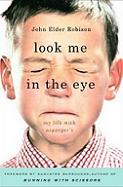Look Me in the Eye: My Life with Asperger’s by John Elder Robison

Review by Kathy Kuhl
Know someone who avoids eye contact, who doesn’t know how to converse, but will talk endlessly about a favorite subject? John Elder Robison’s memoir, Look Me In the Eye: My Life with Asperger’s, gives an inside look at life at one end of the autism spectrum. He provides an example of an “Aspergian” (a person with Asperger’s Syndrome) maturing to become a successful businessman, husband, and father.

Beginning with his preschool days in early 1960’s, Robison recalls how he thought and dealt with people. He remembers being distressed that other three-year-olds did not play with trucks “correctly” and surprised that they were not grateful to be corrected. Later, he writes about adults predicting he would grow up to be a psychopath (because he seemed unresponsive and wouldn’t “look them in the eye”), comments that hurt and worried him, though he did not react.
Calmly, he explains his shocking home life. Though brilliant, his father was abusive and alcoholic. Mental illness destroyed his gifted mother. Robison amused himself and vented his frustrations with science experiments and vandalism. As Robison says, he is no role model. This is a story of slow recovery from a disastrous youth.
Before dropping out, Robison enjoyed his first success in repairing audio equipment at high school. Fixing amplifiers for a local band led to creating exotic guitars for Pink Floyd and Kiss. His life on the road and his friends’ drug abuse and immorality are more reasons I do not recommend this book for children or young teens. Robison wrote this book for adults.
Wanting a steadier life, Robison moved to white-collar jobs and then into management. Later, he opened a shop to restore expensive cars. After twenty years in that business, he employs twelve people.
Why read this book if it has an abusive family, drug abuse, lies, broken marriages, profanity (mainly in the hardcover edition, which I have not read), and immorality?
- Robison’s vivid memories of his childhood behavior give a rare glimpse into why one autistic dealt with people as he did.
- He explains his mental processes: how he thinks about machines and visualizes the calculus of circuitry, predicting circuits behavior almost intuitively.
- He explains the reasons behind several of his typical Asperger’s behaviors.
- He shares resources on Asperger’s that he has found helpful.
- His Asperger’s Syndrome does not keep him from being a caring son, husband, and father. His continued growth in these areas is encouraging.
Like Temple Grandin’s Thinking in Pictures or Mark Haddon’s novel, The Curious Incident of the Dog in the Night-Time, this book helps us see another way of living. Robison demonstrates “that no matter how robotic we Aspergians might seem, we do have deep feelings.”
The fact that a man with autism can write a New York Times bestseller encourages us that our children can excel in surprising ways, too.
Want to learn more? See below:
To look inside this book or purchase Look Me in the Eye, click here.


One Comment